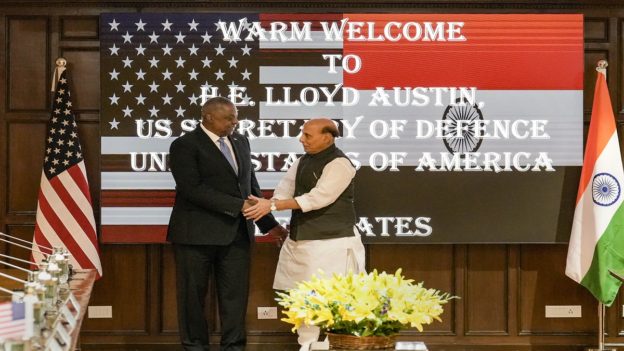India and the US have both agreed to prioritize “co-development and co-production of new and existing technologies,” marking a significant step in their defense partnership.
India and the US have both agreed to prioritize “co-development and co-production of new and existing technologies,” marking a significant step in their defense partnership. And the two countries have initiated negotiations on foundational agreements, such as the “security supply agreement” and “reciprocal supply agreement,” which will enable technology sharing between companies from both countries.
The roadmap concluded during the bilateral meeting between Defense Minister Rajnath Singh and US Secretary of Defense Lloyd J Austin III earlier today will guide US-India defense industrial cooperation policies for the next few years. This collaboration aims to build resilient supply chains, identify opportunities for joint technology development and production, and enhance collaboration between defense start-up ecosystems. This crucial meeting aimed to reinforce the strategic alliance and propel cooperation across critical domains, laying the groundwork for Prime Minister Narendra Modi’s forthcoming official state visit to Washington DC later this month.
The commitment to co-developing key defense platforms underscores the shared vision for a strong strategic technology partnership and defense industrial cooperation.
Also read: GE will produce engines for LCA Mk2 soon – Know more about F414-INS6 engine
US-India Defense Industrial Cooperation
The two countries as reported earlier concluded a new Roadmap for US-India Defense Industrial Cooperation, a groundbreaking initiative that will expedite technology collaboration and co-production. This visionary roadmap encompasses areas such as air combat, land mobility systems, intelligence, surveillance, and reconnaissance, munitions, and the undersea domain. By facilitating access to cutting-edge technologies, this collaboration will propel India’s defense modernization plans and revolutionize cooperation between the US and Indian defense sectors. Both leaders also agreed to address regulatory obstacles impeding closer industry-to-industry cooperation, signaling a commitment to long-term supply chain stability through negotiations on a Security of Supply Arrangement and a Reciprocal Defense Procurement agreement.
Financial Express Online has reported earlier that the two countries are in the process of finalizing two major deals which are expected to be announced when Prime Minister Narendra Modi visits the US later this month. These include the engine maker General Electric to set up a production line for building engines for India’s Light Combat Aircraft `Tejas’ Mk2 and the long awaited 30 Predator UAVs from General Atomics Aeronautical Systems Inc for the three services and Indian Navy is the lead service.
Details related to the GEF414 jet engine have been finalized and will be announced later this month. Also during talks between Singh and his counterpart, India has asked the US to increase sourcing from India for defence orders from here and to establish MRO (maintenance and repair operations) in the country.
Recognizing the growing significance of defense innovation, Secretary Austin and his counterparts delved into emerging domains such as space, cyberspace, and artificial intelligence. According to an official statement issued by the US Department of Defense, they both welcomed the launch of the Advanced Domains Defense Dialogue and vowed to expand the scope of bilateral defense cooperation to encompass all domains. Additionally, they welcomed the establishment of the India-US Defense Acceleration Ecosystem (INDUS-X), an extraordinary initiative by the US-India Business Council set to launch on June 21. INDUS-X aims to foster innovative partnerships between American and Indian companies, investors, start-up accelerators, and academic research institutions, supplementing existing government-to-government collaboration.
Also read: India soon to jointly manufacture jet engines for LCA-Mk2
Emphasizing the importance of operational collaboration, the Secretary and Minister Singh committed to strengthening cooperation across all military services, with a focus on supporting India’s prominent role as a security provider in the Indo-Pacific. They explored avenues to enhance information sharing and deepen cooperation in the maritime domain. Secretary Austin lauded India’s leadership in the Quad Indo-Pacific Maritime Domain Awareness Initiative (IPMDA), a groundbreaking endeavor that will provide cutting-edge domain awareness capabilities to nations across the Indo-Pacific region.
During his meeting with National Security Advisor (NSA) Ajit Doval, the visiting Secretary engaged in discussions on regional and global security concerns, with particular attention to maritime security in the Indian Ocean Region. And he welcomed NSA Doval’s perspective, fostering an understanding of shared security interests and objectives, including the exploration of greater maritime collaboration.
Throughout his meetings, Secretary Austin reiterated the central role of the US-India partnership in upholding peace and security in the Indo-Pacific region. This visit further strengthened the foundations of an unbreakable alliance, poised to tackle evolving challenges and shape the future of the Indo-Pacific security landscape.
https://www.financialexpress.com/business/defence-austin-elevates-us-india-defence-partnership-during-india-visit-gef414-jet-engine-details-finalised-3114640/





